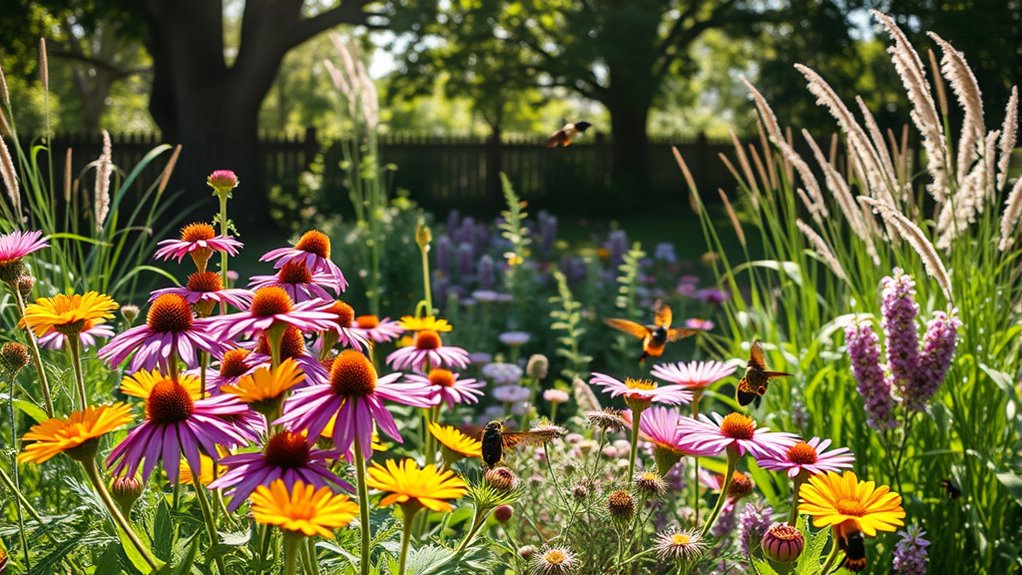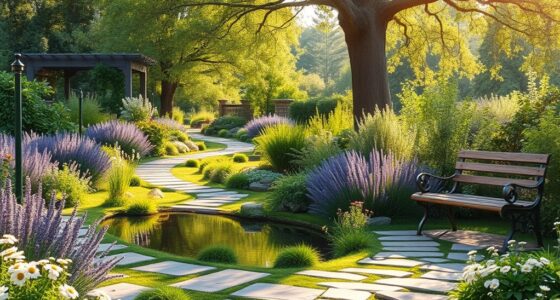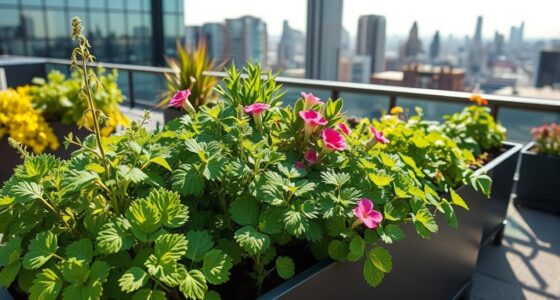Transforming your lawn into a pollinator-friendly space involves replacing traditional grass with native plants that support bees, butterflies, and other beneficial insects. Focus on incorporating a variety of native wildflowers, shrubs, and perennials to provide continuous food sources and habitat diversity. Use fewer chemicals and consider natural pest control methods to protect pollinators. Creating these vibrant, sustainable spaces not only benefits local ecosystems but also enhances your outdoor environment—learn more to discover simple steps to get started.
Key Takeaways
- Replace sections of lawn with native flowering plants to provide continuous pollinator food sources.
- Incorporate a variety of native wildflowers, shrubs, and perennials for habitat diversity.
- Minimize chemical pesticide use by promoting natural pest control methods like beneficial insects.
- Design low-maintenance native plant patches or borders that blend seamlessly with existing landscapes.
- Focus on planting native species to support local pollinators, enhance biodiversity, and improve overall ecosystem health.

Many traditional lawns are sterile and offer little to support pollinators, but you can make a simple change that benefits both the environment and your yard. By replacing sections of your grass with native plants, you create a welcoming habitat for bees, butterflies, and other pollinators. Native plants are adapted to your local climate and soil, requiring less water, fertilizers, and pesticides. This not only helps the environment but also reduces your yard’s reliance on chemical treatments, making it safer for pollinators and your family.
Introducing native plants into your landscape is straightforward. Start by identifying species that naturally thrive in your region. These plants provide essential nectar and pollen sources that are unavailable in a typical lawn. Incorporating a variety of native flowering plants ensures a steady food supply throughout the growing season, supporting pollinators at different life stages. You might consider including wildflowers, shrubs, and perennials to diversify your yard’s habitat. This diversity not only benefits pollinators but also creates a more dynamic and attractive landscape for you to enjoy.
Start with native plants that thrive locally to support pollinators and enhance your landscape.
Reducing pesticide use is an indispensable step toward creating a pollinator-friendly space. Many pesticides are highly toxic to bees and butterflies, impairing their ability to forage, reproduce, or even survive. By opting for native plants, you naturally attract beneficial insects that help control pests without the need for chemical interventions. Additionally, you can implement integrated pest management (IPM) practices, such as manual removal or encouraging natural predators, which minimize pesticide reliance. Over time, your yard becomes a healthier environment for pollinators and humans alike.
Creating a habitat that supports pollinators aligns with the broader goal of AI-driven environmental solutions to promote biodiversity and sustainability. Transforming your lawn into a pollinator habitat doesn’t mean sacrificing your outdoor aesthetic or functionality. You can design a low-maintenance, native plant garden that blends seamlessly with your existing landscape. Consider creating small patches or borders dedicated to native flora, or incorporate native plants into your existing flower beds. The key is to prioritize diversity and native species, which naturally support pollinator health and reduce the need for chemical inputs. Over time, you’ll notice more bees buzzing and butterflies fluttering, signaling a thriving ecosystem right outside your door.
Frequently Asked Questions
What Native Plants Attract the Most Pollinators?
You should choose native plants like coneflowers, bee balm, and milkweed to attract the most pollinators. These plants boost native plant selection and support pollinator diversity by providing essential nectar and pollen sources. When you plant a variety of native species, you create a welcoming environment for bees, butterflies, and hummingbirds. This not only enhances your garden’s beauty but also helps sustain local pollinator populations for healthier ecosystems.
How Do I Maintain a Pollinator-Friendly Lawn Year-Round?
You’re really on the ball to keep your pollinator-friendly lawn thriving year-round. To do so, adapt your seasonal lawn care by planting native species that bloom in different seasons, ensuring a continuous food source. Incorporate water conservation tips like watering early mornings and mulching to retain moisture. Regularly remove weeds and avoid chemicals, so pollinators stay healthy and happy. It’s a balancing act, but persistence pays off.
Are There Any Local Regulations for Creating Pollinator Habitats?
You should check your local zoning laws and habitat restrictions before creating a pollinator habitat. Many areas have regulations on landscaping, native plant use, and habitat modifications, so it’s essential to consult your city or county’s planning department. They can inform you about any permits needed or restrictions to make sure your pollinator-friendly efforts conform to local rules and help protect native ecosystems.
Can I Incorporate Edible Plants Into My Pollinator Garden?
Think of your garden as a symphony of flavors and colors—you can absolutely incorporate edible plants into your pollinator haven. Use composting techniques to enrich your soil, giving roots the nourishment they crave. Garden design tips like planting companion herbs and vegetables alongside native flowers create a harmonious space. Not only will pollinators thrive, but you’ll also enjoy a bounty of fresh produce, making your garden both delicious and eco-friendly.
How Do I Prevent Pests From Damaging My Pollinator-Friendly Space?
To prevent pests from damaging your pollinator-friendly space, you should implement pest control strategies that focus on natural deterrent methods. Use companion planting with herbs like basil or marigolds to repel pests naturally. Encourage beneficial insects such as ladybugs and lacewings, which prey on pests. Keep your garden healthy by avoiding overwatering and proper sanitation, reducing pest attraction, and maintaining a balanced ecosystem that supports pollinators and natural pest control.
Conclusion
By transforming your lawn into a pollinator-friendly space, you’re planting the seeds for a healthier ecosystem. Your efforts can turn a barren patch into a vibrant haven that supports bees, butterflies, and other essential insects. Remember, a little change can go a long way—sometimes, it’s the small steps that make the biggest difference. So, roll up your sleeves and embrace this Gardening 101; after all, every garden begins with a single seed.









